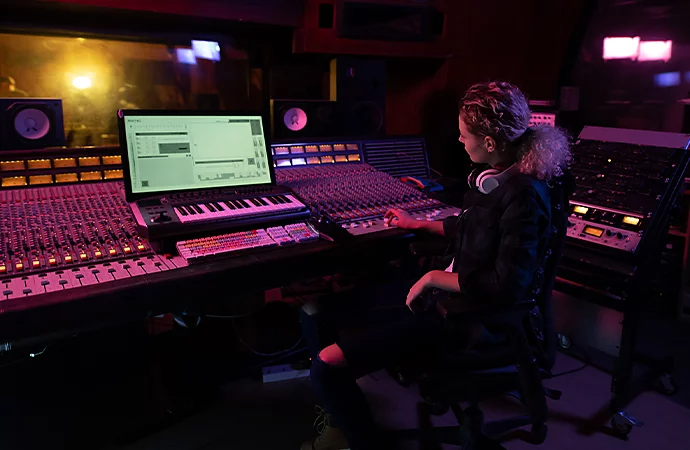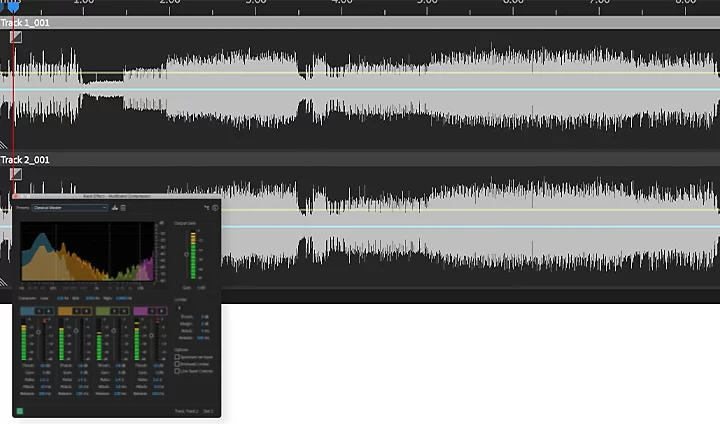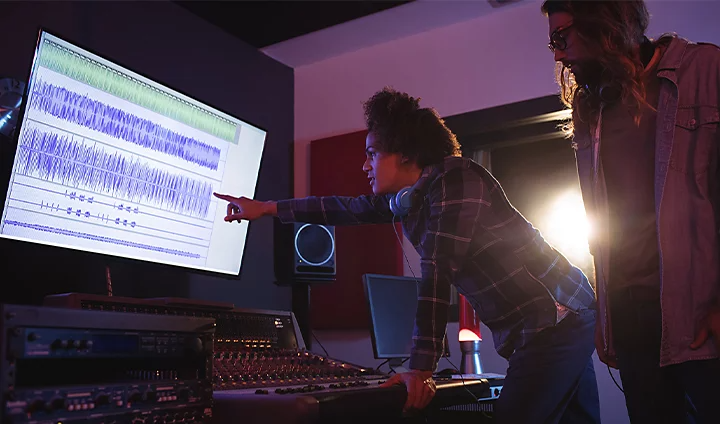
VIDEO
Introducción a la compresión de audio
Aprende a usar la compresión para que tus grabaciones suenen más pulidas, de modo que puedas ofrecer archivos de audio de la mejor calidad posible a tus oyentes.

¿Qué es la compresión de audio?
La compresión de audio es una herramienta muy útil con la que los ingenieros de sonido pueden suavizar el sonido de los instrumentos, las voces y otros elementos, tanto si se trata de mezclar una pista musicalcomo de grabar un podcast. Un compresor de audio tiene la capacidad de reducir el rango dinámico de una señal de audio disminuyendo el volumen de los sonidos más fuertes y aumentando el de los sonidos más silenciosos, desde una guitarra acústica con demasiado sonido de púa hasta un piano que carezca de fuerza.
“Puedes ajustar los niveles para que todo suene bien en un punto, pero a medida que la canción avance, es posible que algunos elementos sean difíciles de oír o que se escuchen demasiado alto y no encajen en la mezcla. La compresión se emplea sobre todo para evitar que esto ocurra, de modo que se obtenga un sonido cohesionado”, explica el productor e ingeniero de mezclas Peter Rodocker.
Los controles básicos de los compresores de audio
Entender los aspectos técnicos y la terminología de la compresión de audio te permitirá trabajar con mayor soltura con una amplia variedad de compresores.
Umbral
El umbral es el nivel al que comienza la compresión. Una vez establecido un nivel del umbral, el audio que esté por debajo de este umbral no se verá afectado, pero el que lo sobrepase se comprimirá según la relación establecido. “Imagina un guitarrista que toca a un volumen constante y, en mitad de la canción, llega a unas cuantas notas muy altas. El compresor debe ajustar de tal forma que el umbral solo capte la parte más alta de la pista”, ilustra Rodocker.
Proporción
La relación es la cantidad de atenuación (o compresión descendente) que se aplicará cuando la señal alcance el umbral establecido. Peter explica que “el volumen del audio se mide en decibelios (dB), por lo que si se establece una relación de compresión de 3:1, por cada 3 dB de la señal de entrada que sobrepase el umbral, se producirá 1dB de señal de salida”.
Tiempo de ataque
El tiempo de ataque es lo que tardar la señal de audio en comprimir completamente a la relación establecida una vez cruzado el umbral. “Afectará a la primera parte del sonido que se escucha, por lo que se puede establecer un ataque más lento para conseguir mayor potencia en un instrumento más suave, como un teclado, y un ataque rápido para comprimir rápidamente el sonido de una púa de guitarra fuerte”.


Tiempo de lanzamiento
El tiempo de lanzamiento es lo que tarda la señal de audio en pasar de ver afectada a no estar comprimida. Con niveles bajos de reducción de ganancia, las velocidades de lanzamiento rápidas suenan más naturales. Sin embargo, una compresión extrema con un tiempo de lanzamiento rápido puede provocar un efecto de bombeo (o un aumento repentino del volumen), lo cual puede hacer que la pista suene irregular en algunos géneros musicales.
Rodilla
La transición es la rapidez con la que el compresor pasa de no comprimir la señal a comprimirla. Una transición suave sonará de forma más gradual, ya que la compresión no comienza tan rápidamente, mientras que una más brusca sonará más dramática. “Los bajos y las voces suenan mejor con una soft knee, mientras que, para cualquier tipo de instrumento de percusión, como un piano o un bombo, yo optaría por una hard knee”, comenta el productor, ingeniero y mezclador Gus Berry.
Ganancia de compensación o de salida
El nivel de la señal que sale de un compresor no será tan alto como cuando entró, pues el compresor baja de forma activa partes de la señal. La ganancia de compensación se emplea para volver a subir el nivel general de la señal. “Para ello, hay que reproducir el material mientras se desactiva y activa el compresor, ajustando la ganancia de compensación hasta que todo suene más o menos al mismo nivel”, aconseja Rodocker.
Cinco tipos principales de compresores
Además de los controles que debes configurar, el tipo de compresor que emplees determinará el efecto general del sonido.
Compresor de tubo
Perfecto para: bajos, baterías y voces.
El compresor de tubo es uno de los tipos de compresión más antiguos que existen; lo emplearon The Beatles y la Motown. “Suelen tener tiempos de ataque y lanzamiento más lentos, y un sonido específico que la gente suele calificar como de la ‘vieja escuela’ o vintage”, explica Rodocker.
Compresor FET
Perfecto para: material agresivo como baterías, instrumentos de percusión, guitarras eléctricas y voces.
Un FET, del inglés “Field Effect Transistor” (transistor de efecto de campo), imita el sonido de tubo con circuitos de transistores, por lo que es un equipo más rápido y fiable que produce un sonido limpio.
Compresor en paralelo
Perfecto para: instrumentos de percusión, bajos eléctricos, voces y sonido en directo.
La compresión en paralelo se consigue mezclando una señal sin procesar o ligeramente comprimida con una versión muy comprimida de la misma señal. Así, se reduce el rango dinámico subiendo los sonidos más suaves.

Compresor de cadena lateral
Perfecto para: bajos y bombos en la música dance pop.
En la compresión de cadena lateral, el nivel de volumen de un instrumento controla el nivel de efecto de otro instrumento. Se puede configurar el bajo para que, cuando suene el bombo, se comprima más y se siga desplazar por la mezcla, creando el sonido de bombeo típico de las mezclas de dance pop.
Compresor multibanda
Perfecto para: voces, guitarras acústicas y baterías.
Un compresor multibanda permite dividir una pista en diferentes rangos de frecuencia y comprimirlos por separado. Por ejemplo, se pueden reducir los graves de una voz cuando son demasiado fuertes, intensos o resonantes, y no modificarlos cuando suenan bien.
Consejos de profesionales para perfeccionar los audios
Antes de ponerte manos a la obra, echa un vistazo a estos consejos profesionales para dominar los conceptos básicos de la compresión de audio.
Comprime con un objetivo
Aunque parezca un proceso más bien intuitivo, los equipos de producción e ingeniería de mezclas no se cansan de repetirlo: “No se debe hacer un uso arbitrario de la compresión; sino que tiene que venir motivado por algo, ya que no siempre hace falta emplear un compresor. Escucha el sonido y descubre si hay algún problema haciéndote preguntas como: ‘¿Hay mucho ataque en esta parte?’, ‘¿Está despareciendo el sonido de fondo?’, ‘¿Hay que subir eso?’. Siempre hay que un plan en todo lo que se haga”, explica Rodocker.
Experimenta con cambios sutiles al principio del proceso de mezcla
Esto te ayudará a escuchar los cambios que produce cada elemento; a partir de ahí puedes retroceder y perfeccionarlo. “Haciendo cambios más sutiles puedes hacerte una idea general más completa que realizando una gran cantidad de trabajo de una vez. Aquí es donde la gente suele atascar al principio. Emplean un compresor y reducen el sonido inmediatamente, con la esperanza de que suene más poderosa y mejor”, explica Berry.

Combina distintos compresores para conseguir el efecto que buscas
Como durante el proceso de mezcla hay que atender a numerosos elementos dinámicos, puede resultar muy útil combinar dos o tres compresores para comprimir ligeramente en distintas partes, en lugar de aplicar una compresión excesiva en un solo punto. Si se emplean varios compresores, se consigue un resultado más natural y menos perceptible, y se logra el mismo efecto sin tener que intervenir demasiado en una voz o en un instrumento”, aconseja Berry.
Agiliza el proceso de edición con la estación de trabajo de audio digital (DAW) adecuada
Las DAW como Adobe Audition permiten añadir plug-ins, previsualizar las ediciones de audio a medida que se aplican y reparar y restaurar el audio para conseguir una mezcla pulida con un sonido impecable. “Los DAW facilitan la puesta en marcha de un proyecto. Incluyen menús desplegables muy prácticos en los que se pueden seleccionar aspectos como la profundidad de bits y la velocidad de ejemplificación, de modo que no hace falta introducir los números exactos o las especificaciones”, comenta Berry.
Independientemente de si empleas diferentes compresores o si experimentas con nuevos plug-ins, ten siempre en cuenta que la compresión de audio consiste en encontrar el equilibrio. El compresor de audio, que se emplea principalmente para reducir el rango dinámico, requiere un enfoque cuidadoso que permita sacar el máximo partido a la mezcla. Empieza por adquirir un manejo básico de cada control y, después, practica con ellos en los cinco tipos principales de compresores que existen. Así podrás dar un paso más en la búsqueda de un sonido que te caracterice.
https://main--cc--adobecom.hlx.page/cc-shared/fragments/seo-articles/do-more-audition-color-blade
